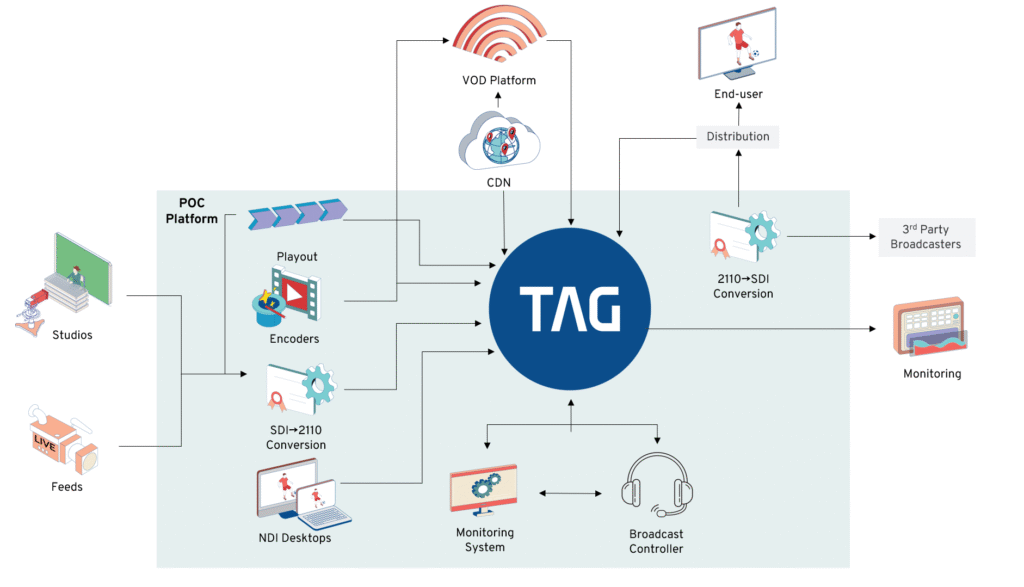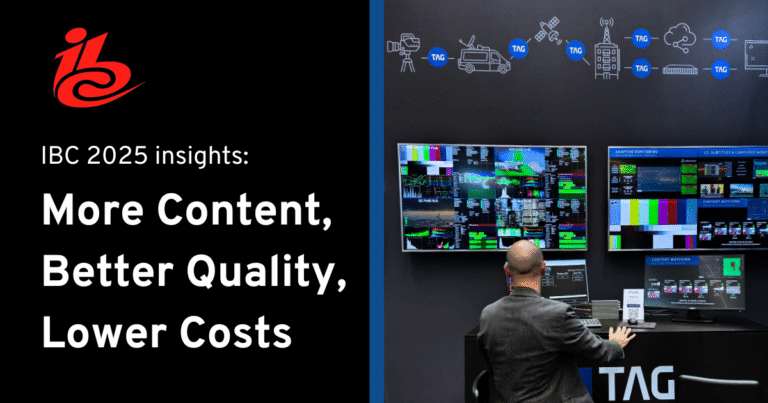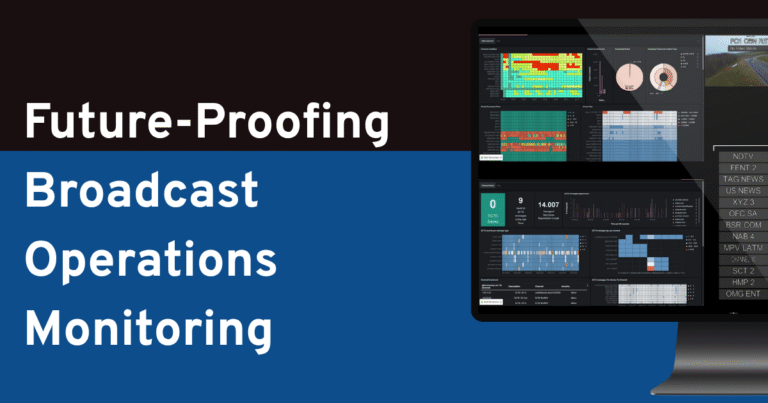Streamlining Live Operations with Media Tailor and TAG Video Systems
At A Glance – The Players
The Broadcaster
A leading public service media organization, the broadcaster operates multiple national TV channels, radio stations, and a digital platform, delivering a wide range of news, entertainment, and cultural programming. Its mission is to serve diverse audiences, promote cultural diversity, and provide trusted, independent content across all platforms.
Media Tailor
Media Tailor is a Nordic media technology partner specializing in content production, management, and distribution. With nearly 30 years of experience, they help broadcasters and content providers navigate complex workflows.
TAG Video Systems
A global leader in 100% software-based, IP-native real-time media performance monitoring, visualization, and analytics solutions.
The Challenge
The broadcaster’s goal was clear: simplify live operations, reduce complexity, and enable scale across a growing portfolio of media workflows. With multiple systems built over time—each with its own processes, tools, and operational silos—managing live video operations had become increasingly inefficient. Operators were juggling different systems for network operations, master control, and monitoring, leading to duplicated effort, limited visibility across workflows, and slower response times when issues occurred.
This wasn’t about solving a specific system failure or addressing an isolated problem. The broadcaster’s leadership recognized that as they migrated from a legacy SDI environment to an all-IP workflow, they needed a unified approach to monitoring. They were seeking a solution that could offer real-time visibility into both uncompressed ST 2110 signals and compressed video streams, without introducing additional operational overhead.Their vision was to consolidate their network operations, master control, and playout teams into a single Live Operations Center (LOC) to drive efficiency and create a more agile, responsive broadcast operation. They wanted to streamline processes, reduce the complexity of managing separate systems, and ensure that operators could monitor and manage multiple workflows across a single interface, with the potential for less changes in staffing needs.
The challenge wasn’t just technical; it was operational. The broadcaster needed a system that could support real-time decision-making, enable proactive issue resolution, and provide the flexibility to adapt as workflows evolved. They wanted to move beyond monitoring individual components in isolation and instead gain a holistic view of their entire broadcast chain, from contribution to distribution.
TAG was selected to help achieve this vision—not as a band-aid for existing problems, but as a critical part of building a smarter, more efficient, and future-ready broadcast operation.
The Solution
To simplify live operations and support scalable growth, the broadcaster needed a unified monitoring platform that could manage both uncompressed and compressed streams across diverse workflows. Working closely with the broadcaster’s technology team, the solution was built around a flexible, software-based architecture designed to reduce complexity, streamline monitoring, and support evolving requirements.
TAG’s Realtime Media Performance platform replaced multiple siloed systems, enabling operators to monitor uncompressed ST 2110 signals and compressed streams from a single interface. This eliminated the need to manage separate tools, reduced eyes-on-glass, and improved situational awareness across the entire live production chain.
The deployment was designed for scale. The broadcaster runs hundreds of TAG licenses across its production and test environments, with an architecture that can flex to accommodate future expansion without requiring additional hardware or staffing.
Seamless integration with existing control systems was a key factor in the solution’s success. TAG’s API-first design enabled tight integration with various orchestration and management tools, enhancing layout and workflow management, as well as providing robust capabilities for centralized system health monitoring. This approach ensured that the monitoring solution could evolve alongside the broadcaster’s infrastructure and operational requirements while maintaining strong interoperability with other solutions.
The solution was not just about technology; it was about aligning with the broadcaster’s workflows and operational goals. By focusing on simplicity, flexibility, and transparency, the deployment delivered a monitoring platform that provides real-time visibility, supports proactive decision-making, and enables the broadcaster to operate more efficiently at scale.

The Results
The deployment of the new monitoring platform has transformed the broadcaster’s live operations. By consolidating multiple siloed systems into a unified monitoring environment, the broadcaster has significantly reduced operational complexity. Teams now manage both uncompressed and compressed signals from a single, centralized interface, streamlining workflows and improving efficiency across the board.
The ability to monitor real-time performance across diverse workflows has reduced the number of screens and manual checks required—minimizing eyes-on-glass while enabling operators to focus on critical issues as they arise. Alerts are generated automatically, helping teams identify and resolve potential problems before they impact service quality. This proactive approach has improved response times and contributed to more reliable service delivery, with fewer on-air incidents reported since the system went live.
The flexibility of the software-based architecture has also proven critical. The broadcaster has been able to scale monitoring capacity in line with evolving needs—adding new channels, supporting additional workflows, and integrating new features without requiring additional hardware or increasing staffing levels . This has not only helped control costs but has also positioned the broadcaster to adapt quickly as market demands shift.
Feedback from the broadcast operations team has been consistently positive. Operators report greater confidence in their ability to manage complex workflows, with improved visibility and fewer manual interventions required. Issues that previously required guesswork—such as Nordic audio handling, subtitle overlaps, or color bar misalignment—have been resolved through targeted feature updates and configuration changes, delivered as part of the partnership with TAG.
Ultimately, the broadcaster has achieved its goal of creating a more efficient, scalable, and future-proof Live Operations Center. With a simplified monitoring environment and the flexibility to adapt, the broadcaster is well positioned to support new services, manage growth, and maintain the high-quality viewing experience that audiences expect.
Looking Forward
The broadcaster’s journey toward a unified, IP-native live operations environment is ongoing. With the Live Operations Center (LOC) now fully operational, plans are in place to further consolidate workflows by integrating the Master Control Room (MCR) into the LOC—creating a single hub for managing all live content. This next phase is expected to deliver additional efficiencies by reducing operational silos and improving resource utilization across teams.
Looking ahead, the broadcaster is also exploring the implementation of TAG’s Penalty Box feature to streamline issue detection across large-scale multiviewer environments. By enabling operators to focus on streams that require immediate attention, the Penalty Box will further reduce eyes-on-glass and support faster response times to potential service disruptions.
In addition, the broadcaster is working to enhance its disaster recovery capabilities, ensuring resilient operations in the face of unexpected events. This includes plans to expand the system’s capacity, integrate additional workflows, and explore the use of advanced APIs for further automation of monitoring processes—such as developing audio alarm systems in collaboration with various technologies to enhance interoperability.
As the broadcaster continues to modernize its infrastructure, the flexible, software-based foundation established through the partnership with TAG and Media Tailor ensures that new features and workflows can be integrated seamlessly. The broadcaster’s teams remain confident that they can scale operations as demand grows, deliver a high-quality viewing experience, and maintain the agility required to navigate the dynamic media landscape.





